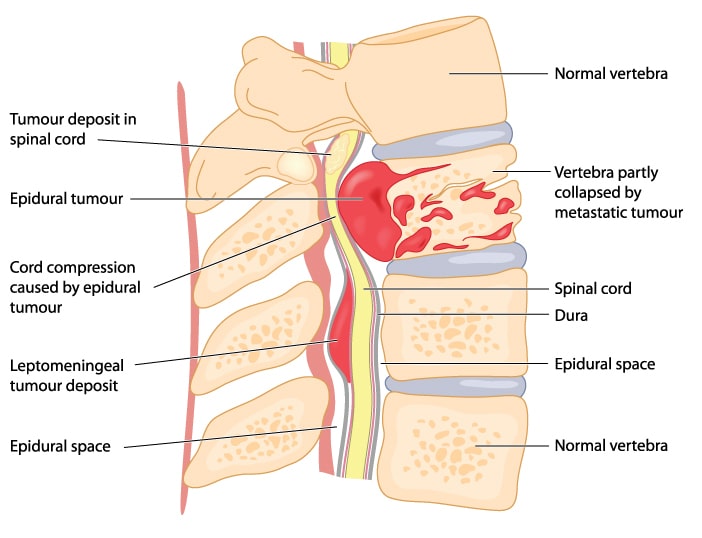Spinal tumors are extremely rare. While central nervous system tumors affect an estimated 359,000 Americans, only 10-15% of those tumors are found in the spinal cord, vertebrae, spinal nerve roots, or dura matter. Additionally, approximately 10,000 of these cases are metastatic, meaning that they originated from elsewhere in the body. This blog post will provide you with all the information you need to know about spinal tumors, including what they are, how they are treated, and the symptoms to look out for.
What is a Spinal Tumor?
A spinal tumor is a mass or lump that develops within the spine or spinal cord. These tumors can be either cancerous (malignant) or noncancerous (benign). Although benign tumors are not as aggressive as malignant tumors, they can still cause serious problems if left untreated. There are four main types of spinal tumors:
Intradural-extramedullary tumors:
These tumors form outside the spinal cord within the membranes that surround the spinal cord (the dura mater). The most common type of intradural-extramedullary tumor is a meningioma. In most cases, these tumors are benign, however they can be hard to remove and have been known to recur.

Intramedullary tumors:
These tumors form within the spinal cord itself. The most common type of intramedullary tumor is an astrocytoma. This type of tumor is primarily found in the thoracic or cervical regions of the spine. They are also likely benign, but can be difficult to remove.
Extradural:
These tumors form on the outside of the dura mater, but may invade nearby bones or tissue. The most common type of extradural tumor is
caused by metastatic cancer, but they can also be schwannomas (also called neurilemmoma), which are benign and can be removed surgically.
Metastatic tumors:
These tumors form when cancer cells spread (metastasize) to the spine from another part of the body. The most common type of metastatic tumors are lung, breast, and prostate. However, lymphoma, melanoma, sarcoma, GI cancers, kidney cancer, and thyroid cancer can all metastasize in the spine.
What are the symptoms of a Spinal Tumor?
The symptoms of a spinal tumor depend on the size and location of the tumor. Common symptoms include:
- Back pain that gets worse over time
- Loss of feeling or paralysis in the legs or arms
- Weakness in the muscles
- Numbness or tingling in the hands or feet
- Loss of bowel or bladder control
- Paralysis
- Loss of sense of position in space/problems walking in the dark
- Scoliosis
Since many of these symptoms are also associated with various other conditions, it is important to be evaluated by a spinal specialist to determine the exact cause of your symptoms.
How are Spinal Tumors diagnosed?

If you are experiencing any of the symptoms listed above, it is important to see a doctor right away. Your doctor will likely order one or more of the following tests:
- X-ray: This test can help your doctor identify tumors in the bones of the spine. It can also allow them to diagnose other conditions such as arthritis or problems with the spinal discs.
- CT scan: This test uses X-rays and computers to create detailed images of the spine. It can show the shape and size of the spinal canal, as well as its various contents and structures.
- MRI: This test uses magnetic fields and radio waves to create detailed images of the spine. It can detect spinal tumors, as well as arthritis.
- Biopsy: This test involves removing a small sample of tissue from the tumor for further testing.
How are Spinal Tumors treated?
The treatment for a spinal tumor depends on the type, location, and size of the tumor. Treatment options include:
- Surgery: This is the most common treatment for spinal tumors. The goal of surgery is to remove the entire tumor.
- Radiation therapy: This treatment uses high-energy beams to kill cancer cells. However, certain tumors can be radioresistant. In these cases, surgery is usually recommended.
- Chemotherapy: This treatment uses drugs to kill cancer cells.
- Targeted therapy: This treatment targets specific genes, proteins, or the tissue environment that contributes to cancer growth and survival.
In Conclusion
In this blog post, we have discussed what you need to know about spinal tumors. We have defined what a spinal tumor is, as well as described the different types of spinal tumors. We have also listed the symptoms of a spinal tumor and discussed how they are diagnosed and treated. If you have been diagnosed with a spinal tumor, it is important to talk to your doctor about all of your treatment options. Treatment for a spinal tumor can be complex, so be sure to ask your doctor any questions you may have.










